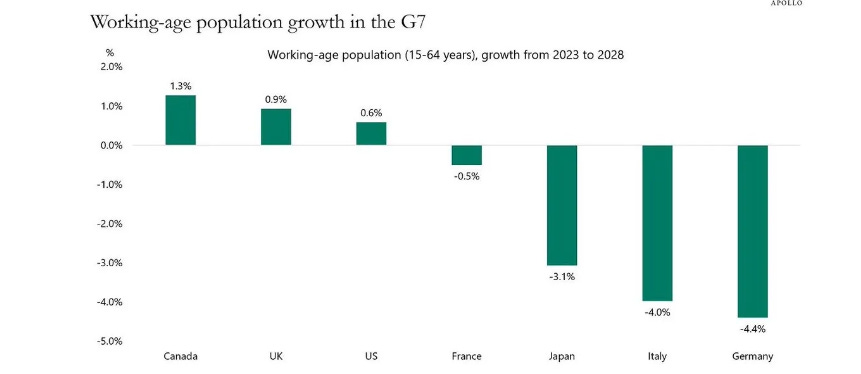Part 1 is here: Perspective on Risk - Aug. 22, 2024 (Big Three Forces, 1 of 2)
(2 of 2)
Demography
Not much new either on the demographic front. Japan and Europe are old and getting older. Japan’s birthrate has hit a new record low. China has passed their point of peak demographic dividend and will age quickly. India and Sub-Saharan Africa are young and their populations are growing quickly. The US is stable as long as we continue to welcome immigrants.
Without Immigrants, US Working-Age Population Would Shrink (Bloomberg)
American births peaked in 2007, and baby boomers are still exiting the labor force in droves. That’s why foreign-born workers are now driving all the job growth.
I’m not a fan of Donald Trump, but he is correct when he says that all employment growth is a result of immigration.
All this is context for understanding the remarkable fact that, according the BLS, all the increase in employment in the US since February 2020 — the month before the Covid-19 pandemic partially shut down the US economy — has been among foreign-born workers.
… without immigration, the US working-age population would be shrinking, and this seems likely to remain the case for the rest of the decade. Immigrants are taking all the jobs because, on net, no one else is available.
Increased wealth and longevity are increasingly important factors. Increased wealth, all else equal, results in declining fertility in countries. Increased longevity changes the ratio of workers to dependents in a society, and changes the nature of the dependents from the young to the aged.
The working age population (and hence workforce) in Germany and Japan in particular is set to fall significantly.
Japan is already facing a labor shortage, and by 2040 it could be short of 11 million workers, a recent study found. In 2022, almost half of Japanese firms relied on workers over the age of 70.
Demographic changes are powerful, if only slowly realized.
These demographic shifts are profound. Whether we like them or not, they are transforming the world. (Wolf)
From the baby boom to the baby bust (Martin Wolf at FT)
This global shift towards very low fertility, with the exception (so far) of sub-Saharan Africa, is among the most important events in our world. One implication is that the population of Africa is forecast to be larger than that of all today’s high-income countries, plus China by 2060.
Extremely low fertility is sure to create huge challenges. One is how to maintain pension or health systems as the population of working age shrinks sharply. One answer will indeed be much longer working lives. Another might be immigration. But the immigration needed to stabilise populations in low, let alone ultra-low, fertility societies would be enormous and, as such, surely politically and even practically impossible.
Japan will likely be the first to see its pension system come under severe stress.
Technology
I’ve written ad-nauseum about the effects that Large Language Models (and AI more broadly) is having. What else is happening?
Brain and spinal cord implants enabled a paralyzed man to walk.1 Brain implants can identify brain waves associated with depression.2 It also may be on the verge of restoring speech to some people.3
CRISPR gene editing was used to develop a cure for sickle cell anemia.4
CRISPR therapy restores some vision to people with blindness5
GLP-1 drugs found to cause weight loss, reduce heart attack and stroke risk, and perhaps help break addictions.6
“Google DeepMind has used a large language model to crack a famous unsolved problem in pure mathematics … the researchers say it is the first time a large language model has been used to discover a solution to a long-standing scientific puzzle—producing verifiable and valuable new information that did not previously exist.”7
Driverless trucks with no humans on board may soon cruise Texas highways8
Obesity meets its match (Science)




